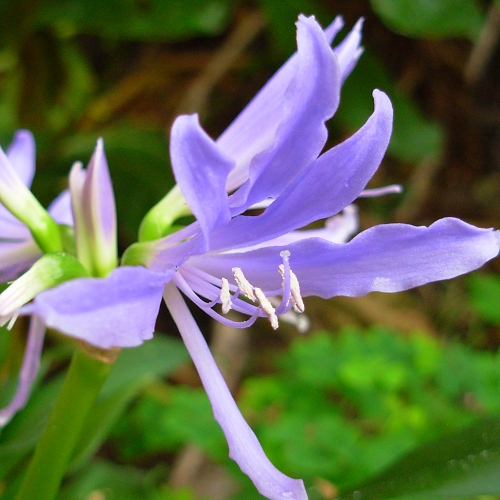Planting your bulb
Getting started -- You may start your bulb in a small pot about 4-5 inches (10-13 cm) wide, and at least 4 inches tall (10 cm), with drainage holes. Use a
well-draining soil mix. A typical mix
is 2 parts quality potting soil Bury it so the top of the bulb is about 1 to 1.5 inches (3-4 cm) deep. Add enough water until the soil is evenly moist, but not fully saturated. Until the bulb sprouts, i recommend keeping it between 65 and 82 degrees F (18-28°C) both day and night. Ensure that the soil doesn't dry out, but also don't keep it soggy. The bulb can take anywhere from 2 weeks to 3 months to sprout. If your bulb has leaves -- To keep the leaves from wilting after repotting, start it in very high humidity (over 90%) the first 10 days and then gradually lower the humidity. An easy way to do this is explained on this page. Note that an older leaf or 2 may still wilt after this method, but the newer growth should be perky. Light -- It comes from dense rain forests, so it is happiest in bright, filtered light. Some weak sun or dappled sun is fine if the leaves don't wilt, but avoid strong sun. In dimmer light, it will grow larger leaves, but the spots might not be as numerous. See: "Growing indoors with LED lights". Watering -- Keep the soil evenly moist at all times, except when the bulb goes dormant. Temperature -- Optimal temperatures are between about 65 and 90 degrees F (15-33 degrees C). It can tolerate cooler conditions, but it may go dormant if it gets too cold. It needs protection from frost. Over about 40-45% humidity is best. If your plants seem to suffer from low humidity indoors, consider using an ultrasonic humidifier. Fertilizer -- It has average fertilizer needs. Feed about every 3-4 months with a general-purpose fertilizer that contains micronutrients (I use this). It's normal for an old leaf to occasionally turn yellow and then brown, but if it seems excessive, check that the soil is moist enough down in the root zone (a moisture meter may be used for this). If you're sure the roots were moist enough, the plant may need more fertilizer. Dormancy - It may occasionally go dormant or semi-dormant, and if it does, reduce the watering and keep the soil lightly moist for 2-3 months. Avoid letting it dry out completely. Pests to watch for -- Mealybugs may attack the bulbs (look for cottony growth where the leaves emerge from the ground). To control mealybugs, try using an insecticidal soap soil drench. Feel free to separate any baby bulbs that form, but keep in mind that disturbing the mother bulb's roots sometimes delays flowering. Have fun growing it! - Jeff Strange Wonderful Things
|
|||||||||


